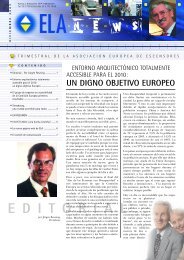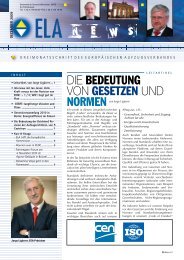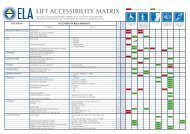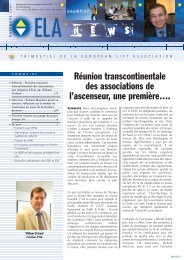WP6-Brochure-E4 brochure - ELA European Lift Association.
WP6-Brochure-E4 brochure - ELA European Lift Association.
WP6-Brochure-E4 brochure - ELA European Lift Association.
You also want an ePaper? Increase the reach of your titles
YUMPU automatically turns print PDFs into web optimized ePapers that Google loves.
It is evident that the way lifts are controlled has a major impact on energy consumption. By<br />
efficiently delivering passengers with the least amount of trips, starts and stops, and number<br />
of lifts used, the energy consumed is significantly reduced. Also, less effective traffic<br />
controllers, causing longer waiting times, can lead to the improper use of the system by<br />
impatient passengers (e.g. pushing both up and down buttons), further degrading the quality<br />
of the service.<br />
Provided passenger’s waiting times are kept within reasonable limits, the energy consumed<br />
should be minimised. A number of different strategies can be engaged to achieve this purpose:<br />
• Shut down lifts during periods of low traffic demand<br />
<strong>Lift</strong> groups are designed to respond optimally to heavy traffic demand situations, such as<br />
during up‐ or down‐peak demand. During interfloor traffic, the capacity of the installation is<br />
never fully used. Therefore, it may make sense to disable some of the lifts in the installation<br />
during this low demand periods, without significantly affecting the system’s traffic handling<br />
performance. This would by itself produce considerable energy savings, but it has one side<br />
effect that further enhances the energy efficiency of the installation. By reducing the number<br />
of lifts in use, the car load is increased, moving closer to the counterbalancing ratio.<br />
• Appropriate zoning arrangement<br />
In high‐rise buildings, it is possible to group the lifts to serve particular zones of floors. This<br />
creates the need for people travelling to floors within that zone to use the same lifts, thereby<br />
reducing the number of start / stop cycles made and avoiding unnecessary energy losses.<br />
Appropriate zoning arrangement will not only improve the energy performance of the lift<br />
installation, but it will also improve the handling capacity and the quality of the service due to<br />
a shorter Round Trip Time.<br />
• Use of advanced algorithms<br />
Employing advanced algorithms that track where each lift is located, to consider the potential<br />
energy available from its car and counterweight locations.<br />
• Monitoring Devices<br />
Modern controllers have logging capabilities which are indispensable for maintenance<br />
purposes. They register data related to failures, but can also provide additional data that can<br />
be used to improve the performance of the system. By logging information on the energy<br />
consumption of lifts a means of conducting energy audits is also provided. The availability of<br />
information improves the awareness of building owners / managers on the electricity<br />
consumed by the system. This information may also be combined with other information<br />
logged by the controller (e.g. traffic patterns, idle times, and load) and used to improve the<br />
energy performance of the installation.<br />
35

















